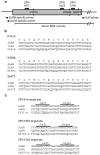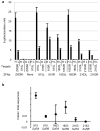High-frequency modification of plant genes using engineered zinc-finger nucleases
- PMID: 19404258
- PMCID: PMC2743854
- DOI: 10.1038/nature07845
High-frequency modification of plant genes using engineered zinc-finger nucleases
Abstract
An efficient method for making directed DNA sequence modifications to plant genes (gene targeting) is at present lacking, thereby frustrating efforts to dissect plant gene function and engineer crop plants that better meet the world's burgeoning need for food, fibre and fuel. Zinc-finger nucleases (ZFNs)-enzymes engineered to create DNA double-strand breaks at specific loci-are potent stimulators of gene targeting; for example, they can be used to precisely modify engineered reporter genes in plants. Here we demonstrate high-frequency ZFN-stimulated gene targeting at endogenous plant genes, namely the tobacco acetolactate synthase genes (ALS SuRA and SuRB), for which specific mutations are known to confer resistance to imidazolinone and sulphonylurea herbicides. Herbicide-resistance mutations were introduced into SuR loci by ZFN-mediated gene targeting at frequencies exceeding 2% of transformed cells for mutations as far as 1.3 kilobases from the ZFN cleavage site. More than 40% of recombinant plants had modifications in multiple SuR alleles. The observed high frequency of gene targeting indicates that it is now possible to efficiently make targeted sequence changes in endogenous plant genes.
Figures


Comment in
-
Plant biotechnology: Zinc fingers on target.Nature. 2009 May 21;459(7245):337-8. doi: 10.1038/459337a. Nature. 2009. PMID: 19458706 No abstract available.
References
-
- Bibikova M, Beumer K, Trautman JK, Carroll D. Enhancing gene targeting with designed zinc finger nucleases. Science. 2003;300:764. - PubMed
-
- Porteus MH, Baltimore D. Chimeric nucleases stimulate gene targeting in human cells. Science. 2003;300:763. - PubMed
-
- Wright DA, et al. High-frequency homologous recombination in plants mediated by zinc-finger nucleases. Plant J. 2005;44:693–705. - PubMed
Publication types
MeSH terms
Substances
Associated data
- Actions
Grants and funding
LinkOut - more resources
Full Text Sources
Other Literature Sources
Miscellaneous

